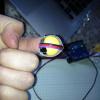BACKGROUND:: Bowel symptoms are common in patients with multiple sclerosis, but current treatment is empirical.
OBJECTIVE:: This study aimed to identify effect of biofeedback on bowel symptoms, mood, and anorectal physiology in patients with multiple sclerosis.
DESIGN:: This was a prospective observational study: the amount of change between pre- and posttreatment values of outcome measures was compared and analyzed. Responders were considered to be patients who demonstrated an improvement greater than or equal to the 25th percentile of the change in bowel score. Comparison between responders and nonresponders was performed.
SETTINGS:: This investigation was conducted at a neurogastroenterology clinic, tertiary referrals center.
PATIENTS:: Thirty-nine patients with multiple sclerosis and constipation and/or fecal incontinence were included in the study.
INTERVENTION:: Patients were given bowel biofeedback therapy.
MAIN OUTCOME MEASURES:: The primary outcome measures were the Wexner Constipation and Wexner Incontinence scores. The secondary outcome measures were hospital anxiety and depression scores and anorectal physiology parameters.
RESULTS:: Data are reported as median and interquartile ranges. After biofeedback there was significant improvement in Wexner Constipation (12 (5-19) pretreatment vs 8 (4-14) posttreatment, P = .001), Wexner Incontinence (12 (3-15) pretreatment vs 4 (2-10) posttreatment, P<.001) and hospital depression scores (7 (3-11) pretreatment vs 5 (3-10) posttreatment, P = .015). The 5-second endurance squeeze pressure was also improved (21 (11-54) mmHg pretreatment vs 43 (26-59) mmHg posttreatment, P = .001). Posttreatment change of Wexner Constipation was -2(-5/0), and of Wexner Incontinence was -3(-9/0) ("-" indicates improvement). Therefore, those patients who had a reduction of at least 5 points in the Wexner Constipation score and/or of at least 9 points in the Wexner Incontinence score were considered responders (18 patients, 46%). They showed a greater improvement of only 5-second endurance squeeze pressure (23.5 (7.5/32.75) mmHg responders vs 4 (-6/20) mmHg nonresponders, P = .008); no difference was observed in the comparison of baseline variables with nonresponders. Significant negative relationship existed between the change in the Wexner Constipation score (-2 (-5/0)) and the pretreatment Wexner Constipation score (12 (5/19),β = -0.463, P<.001), and the change in the Wexner Incontinence score (-3 (-9/0)) with the pretreatment Wexner Incontinence score (12 (3/15),β = -0.590, P<.001). So, the higher the initial bowel symptom score, the greater the improvement.
LIMITATIONS:: This study was limited by the lack of a control group.
CONCLUSIONS:: Biofeedback improves bowel symptoms, depression, and 5-second endurance squeeze pressure in patients with multiple sclerosis.
